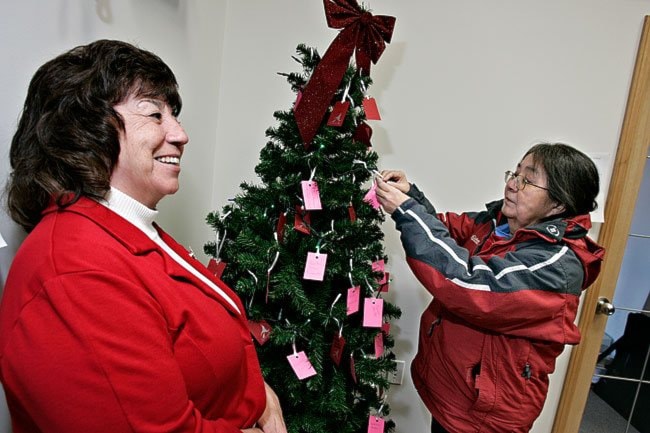The Christmas tree in the foyer of the Council of Yukon First Nations is slowly turning red.
The tree is a memorial for residential school survivors who have died.
Red tags hanging on its branches bear names of the deceased, and sometimes a memory of their life or a brief message written by those who loved them.
“Everybody has residential school survivors in their family, friends, loved ones that we don’t always get the chance to talk about,” said Ingrid Isaac, co-ordinator of residential school survivor programming at CYFN.
At least three quarters of all council employees have a direct connection to a survivor, if they are not a survivor themselves, she says.
“This was a way that we could remember those and honour those memories at a difficult time of year. It’s a tool to grieve healthily.”
“It’s grieving out loud,” said Grand Chief Ruth Massie. “I participated and put a couple on there for some of my schoolmates,” she says looking over to the small Christmas tree blinking in the corner.
Massie got up and approached the tree as Elder Bessie James, of the Carcross/Tagish First Nation, added a tag.
She looked over James’ shoulder.
“Oh I remember them!” she said.
The two women began reminiscing about the person, their family and the good times they’ve had together.
Ottawa says 1,323 Yukon First Nation people attended residential school, but another 161 claim they attended but have had their settlement claim rejected.
Individual First Nations may have an idea who attended the schools and have since passed away, but there is no formal record held by CYFN, said both Massie and Isaac.
Not all residential school survivors have died from natural causes.
Alcoholism, abuse and suicide have been rampant throughout survivor communities across Canada.
But again, there are no records.
“It’s not only drinking, it’s self-abuse,” said Massie.
While the settlement money helped some people, it fueled the destructive habits of others.
“It certainly is the effects of the release of some of the residential school settlement money directly to the individuals,” said Massie. “I know at our leadership table there was a time when we had talked about trying to change lump-sum payments into more program and services-driven activities.”
Now most of the money is gone, and people who are trying to change or improve their lifestyles are finding little support, she said.
“With CAIRS (Committee on Abuse in Residential Schools) and with the poor care they are receiving for after-care programming or services, that’s a pretty good indication of ‘The money’s there, it’s gone, whatever,’ and there’s no after-care – there’s no support services like there should be,” said Massie.
When the federal government announced it would not be refunding the national Aboriginal Healing Foundation this year, centres like CAIRS in Whitehorse and the Liard Aboriginal Women’s Council in Watson Lake – that both work almost exclusively with the effects of residential school - lost the government grants that kept their doors open.
Today, CAIRS is still there, albeit with fewer staff and programs, but it is a day-to-day existence, organizers said.
“We can’t always take it sober, but we’re still living with it,” said Isaac, looking at the tree.
“It’s reminding people too that the issue of residential school hasn’t gone away. It’s still at the forefront of our minds.”
The memorial will remain at CYFN until December 17. Notice of the tree was sent out to all Yukon First Nation communities, but no word has been received yet on whether others have been put up, said Isaac.
People are welcome to come to the council and talk to any of the Resolution Health Support Workers, said Isaac. There is also the National Indian Residential School Crisis Line, which operates 24-hours/day: 1-866-925-4419.
Contact Roxanne Stasyszyn at roxannes@yukon-news.com
